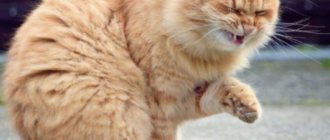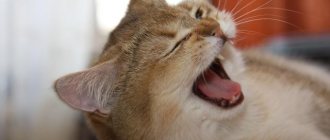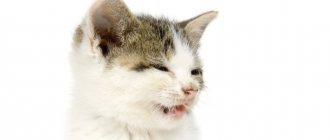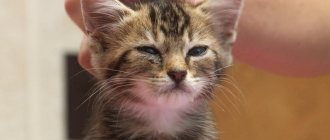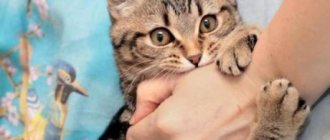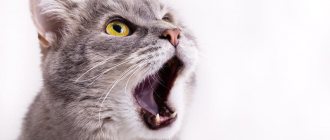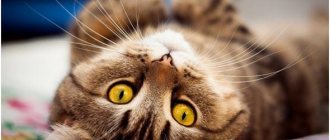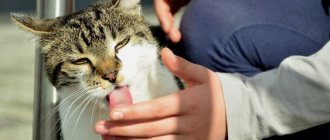Owners of cats often have to watch their pets sneeze or snort. In this case, a cat’s sneezing can be either one-time or multiple. Sneezing itself in cats, like in humans, has a protective function. However, if this physiological process in a cat becomes permanent, the owner needs to pay close attention to the health of his pet. Are there any additional symptoms that are bothering the cat? If these symptoms and lethargy are detected, you should immediately contact a veterinarian.
Why does a cat sneeze at normal body temperature in the absence of other symptoms of illness?
Some cat owners often panic and do not know what to do if the cat sneezes at normal body temperature and normal health. Let us immediately reassure you that in this case there is no reason for special concern. Ordinary house dust can cause your pet to sneeze. The answer to the question why a cat sneezes is often quite simple: the cat’s nasal mucosa is irritated as a result of heavy dust in your apartment. All you need to do is carry out a thorough wet cleaning of the room and this factor that is harmful to the cat and causes sneezing will be eliminated. It will become easier for your pet, and you yourself, to breathe if you additionally get rid of unnecessary old things and carpets that absorb dust.
When figuring out why your cat often sneezes, you definitely need to check your nose for foreign matter. The cat usually removes small foreign objects by sneezing. If it is large, then using tweezers you can try to remove the object yourself. If this cannot be done, you will need to seek help from a veterinary clinic.
However, the process of sneezing in a cat is not always so harmless. The reasons why a cat sneezes can be serious and pose a threat to the animal's health . Such reasons include :
Infection
If your pet begins to sneeze frequently, this is one of the first symptoms of inflammatory processes in the animal’s respiratory system. A cat can catch infections caused by fungi, viruses or bacteria.
With such diseases there are symptoms that appear parallel to a sneeze:
- Cough, heavy breathing with a barely noticeable whistling;
- The pet begins to discharge pus from the eyes;
- High body temperature of the animal;
- Prolonged neglect of water and food;
- Wet spots on the face, the cat rubs it on pieces of furniture and scratches it with its paws.
In this case, self-medication is unacceptable; you should contact the clinic so that a qualified veterinarian can prescribe treatment.
Allergic reaction
The most common allergens in cats include air fresheners, laundry detergent, household cleaning products, cat litter, perfumes, perfumes, etc. Often allergies in cats are caused by the presence of mold in the apartment, pollen from indoor and outdoor plants. Smoke can be a strong allergen and irritant for a cat if there is smoking in the apartment. Any aerosols intended to treat cats against skin parasites (fleas in cats) can lead to a sneeze reflex. Sneezing in a cat may occur when the owners used sprays and aerosols to kill insects in the apartment. In case of an allergic reaction, in addition to sneezing and the cat, other symptoms may be observed: itching (dermatitis in cats), lacrimation (conjunctivitis in cats).
In what cases should you consult a doctor?
So, sneezing that seems harmless at first glance can often be a sign of a serious illness. What should the owner do if the animal constantly suffers from sneezing? Of course, you need to go to the doctor as soon as possible. In the following cases, you should contact a specialist immediately:
- If you sneeze and there is blood coming from your nose (what if it’s cancer?);
- If your cat has snot or pus flowing profusely and constantly from her nose;
- If the cat breathes hoarsely with an open mouth;
- If, in addition to sneezing, there are other symptoms of ill health (fever, reluctance to eat, cough, etc.).
Infectious diseases
Infectious rhinotracheitis, calcivirus - these diseases are often accompanied by a response from the cat’s body. The herpes virus (the causative agent of infectious rhinotracheitis) affects the mucous membranes, which leads to frequent sneezing. In addition to this symptom, a sick cat has a runny nose, high fever, cough, and conjunctivitis. More details in our article - infectious rhinotracheitis in cats. Calcivirus is also an infectious disease and is characterized by frequent sneezing of the animal, refusal to feed due to the formation of ulcers in the mouth, and damage to the joints. More detailed information about this virus can be found in our article - calicivirus infection of cats. Sneezing can accompany diseases such as feline immunodeficiency virus, feline panleukopenia, chlamydia (feline chlamydia), mycoplasmosis (mycoplasmosis in cats), bordetellosis. These infections occur with increased body temperature, discharge from the eyes, and loss of appetite. Often the reason that a cat sneezes is asthma, in which, in addition to multiple sneezes, there is difficulty breathing, wheezing, and attacks of suffocation.
Medicines
The type of drugs and treatment regimen depend on the disease and are determined by the veterinarian.
- Antiviral agents: Fosprenil, Maxidin, Vitafel
- Antibiotics (penicillins and cephalosporins): Cefa-kure, Amoxicillin, albipen LA, Ampiox for young animals.
- Immunostimulants : Mastim, Immunofan
- Intranasal drops: Anandin, Fosprenil, Maxidin.
- Antihistamines: Terfenadine, Clemastine.
- Antihelmintics: Febtal, Prazitel.
- Means for eliminating and preventing various manifestations: Ringer's solution for dehydration, Vetom-1 for diarrhea
- Vitamin complexes: Gamavit, Tsamaks. SA-37.
- Polyvalent (containing more than one type of antigen) vaccines Multifel-4, Quadrikat, Nobivak Rabies.
The vaccine is given after complete recovery.
Worm infestations
Worm infestations that constantly threaten cats can cause sneezing: toxoplasmosis, dirofilariasis.
In the acute form of toxoplasmosis, the cat becomes lethargic, refuses to eat, has a high body temperature, coughing, sneezing, runny nose, lacrimation, shortness of breath, and heavy wheezing breathing. When the nervous system is involved in the pathological process, the cat develops convulsions, muscle tremors, twitching, and in severe cases, paralysis. Sometimes there is a disturbance in the functioning of the gastrointestinal tract (vomiting, diarrhea, constipation). If the liver is damaged, there is an icteric discoloration of the visible mucous membranes. More details about toxoplasmosis in the article – toxoplasmosis in cats.
Dirofilariasis (heart parasites transmitted by mosquito bites) develops in the heart muscle and leads to sneezing, dry cough, shortness of breath similar to asthma, increased fatigue, weight loss, heart failure, upon auscultation - heart murmurs, rapid heartbeat. Read more about this disease in our article - dirofilariasis.
Cold
Colds are provoked by different types of viruses, the symptoms are similar to those of humans - cough, periodic sneezing, mucous discharge from the nasal canals.
- If the cold is advanced, the cat begins to breathe through its mouth.
- The temperature rises in rare cases, but the nose noticeably dries out and becomes hot, which is why cracks often appear on it.
- The cat doesn’t like this at all, and she tries to lick her nose often in order to somehow wet it.
Colds in pets, as a rule, last no more than 4-5 days, after which the inflammatory phenomena gradually subside. A sick pet has difficulty distinguishing and perceiving odors.
Symptoms of cat sneezing that should alert their owners
In the case when, along with sneezing, we observe a deterioration in the cat’s well-being, it is necessary to rush to the veterinary clinic, where specialists will determine the reason why the cat is constantly sneezing. When conducting a clinical examination of your cat, a veterinarian excludes a reaction to dust and does not find a mechanical irritant. When visiting a veterinary clinic, specialists will conduct additional tests on the cat to rule out the allergic nature of sneezing. Then you will know why the cat sneezes and what to do to cure it. By leaving things to chance, you can miss serious diseases, many of which threaten human health. For example, a cat infected with toxoplasmosis can cause a miscarriage in a pregnant woman. Prolonged sneezing, accompanied by additional symptoms (cough, runny nose, high fever, vomiting, etc.), is a reason for its owner to immediately undergo a comprehensive examination at a veterinary clinic. Warning symptoms: bloody discharge from the nose when sneezing; sudden weight loss in a cat; growth of ulcers on the body; wool stuck together in clumps; diarrhea; vomiting; purulent nasal discharge and lacrimation; attacks of fever; whistling when breathing; wheezing cough; aggressive attacks towards the owner; photophobia. If you notice even one or two of these symptoms, rush to the veterinary clinic. Timely treatment can quickly help return your pet to the bosom of the family.
What happens when a cat sneezes
Sneezing is a protective natural reaction of the body to the appearance of an irritant in the nasal passages.
A long inhalation when sneezing precedes a sharp exhalation, due to which interfering particles leave the nasal passages. This behavior is typical not only of cats, but of any animal. A single sneeze is not a cause for concern. However, if it occurs regularly, you should take care of your pet’s health.
There is no need to panic and take your cat to the veterinarian immediately. It is necessary to observe the animal’s behavior and determine the presence of accompanying symptoms. This will help the veterinarian determine the correct diagnosis and begin timely, appropriate treatment.
Treating a cat for sneezing
Only a veterinary specialist at the clinic can prescribe the correct treatment for a cat with symptoms of sneezing. If, during a clinical examination of your cat, a veterinarian determines that your cat is clinically healthy, he will recommend that you wet clean your apartment and use a special humidifier.
If the cause of sneezing is allergic in nature, then recommendations will be given to eliminate the allergen present in the apartment or to ensure that household chemicals are inaccessible to your cat. In order to alleviate the condition, a veterinarian will prescribe one or another antihistamine to your animal.
In the case where the cause of sneezing is polyps, it will be recommended to remove them surgically in a veterinary clinic.
If a cat's sneezing is accompanied by an asthmatic attack, antispasmodics, vasoconstrictors and corticosteroids are prescribed.
In case of diseases of the oral cavity (teeth, gums), a sick cat is given dental treatment, tartar is removed (tartar in cats), inflammation of the gums is relieved, and vitamins are prescribed.
If a helminthic infestation is detected in a cat during an examination, the veterinarian will prescribe special anthelmintic drugs.
If the cause of a cat’s sneezing is an infectious disease diagnosed in the clinic’s laboratory, then the sick animal will be prescribed antibacterial and antiviral drugs and immunomodulators.
The oncological cause of sneezing in a cat is eliminated by performing surgery to remove the tumor and prescribing a course of chemotherapy.
Folk remedies
In parallel with the doctor’s prescriptions, you can use traditional recipes.
- Saline solution. Stir half a tbsp in a liter of water. l. salt. The nasal and oral cavities are washed with the solution.
- Aloe juice is a natural antiseptic. Place a drop in each nostril three times a day.
- Herbal decoction. Mix according to Art. l. pharmaceutical chamomile and marigold flowers, pour boiling water (liter), leave for 2 hours. The affected organ is washed with the filtered cooled solution.
Saline solution can be used to rinse before using intranasal drops prescribed by a veterinarian.
Prevention
If the cat’s sneezing is harmless and caused by the presence of dust in the apartment, then the owners will need to keep their apartment clean and regularly carry out wet cleaning of the room. If sneezing is allergic, owners must protect their pet from the allergen (air freshener, perfume, perfume, washing powder, tobacco smoke, etc.).
An effective way to prevent the infectious component of cat sneezing is to vaccinate animals according to the existing schedule. Starting from six months, you need to follow the vaccination schedule and vaccinate them against: viruses; cat flu; leukemia and leukopenia; rabies.
Oral diseases are prevented by constant monitoring of the condition of the oral cavity and teeth, and timely removal of tartar.
Worm infestations in cats are prevented by regular deworming of the animal with anthelmintics.
The main thing is to undergo regular preventive examinations of your cat at a veterinary clinic in order to detect danger in time and begin timely treatment.
Asthma
The first symptoms of asthma in cats are noticeable in childhood. When an attack occurs, the kitten sneezes, sniffles, wheezes, and breathes with its mouth open. After such attacks, the pet can lie in a secluded corner for 3-4 hours, while not approaching water or food.
- Adult cats with asthma have a poor coat, appear thin and lethargic, and do not show much activity.
- Anything can trigger an attack - dust, detergents, a change of environment.
You need to understand that this disease cannot be treated, so the owner and pet will have to live with it all their lives; only drugs are used that reduce the frequency of attacks or alleviate them.
Household factors affecting pet health
What you should pay attention to when a cat starts sneezing is the conditions in which it is kept. The most common reason is poor cleaning.
Superficial dust removal and floor washing do not guarantee the cleanliness of the room. As you know, dust consists of small parts of dead skin cells, bacteria and insects.
Cleaning must include:
- Furniture;
- Carpets;
- Hard-to-reach areas (corners, under-bed space, top shelves).
The pet, due to its natural abilities and instincts, often climbs into hard-to-reach places. Therefore, dust remains on his fur, which causes frequent sneezing.
If the sneeze persists, then you should pay attention to the presence of drafts in the house. Some breeds are susceptible to colds and deterioration of their condition.Drafts are often the reason why British cats, Sphynx cats, Siamese cats and Scottish breeds sneeze.
